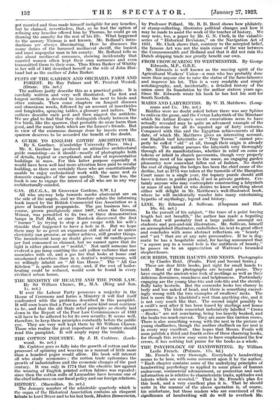MAZES AND LABYRINTHS. By W. II. Matthews. (Long- mans and
Co. 18s. net.) Riddles were no doubt asked before there was any Sphinx to enliven the game, and the Cretan Labyrinth of the Minotaur which Sir Arthur Evans's recent excavations seem to have actually revealed may be quite an advanced example of the puzzle-in-stone for all its reputed age of forty centuries. Compared with this and the Egyptian achievements of like date, of which Mr. Matthews gives an interesting account, our English turf labyrinths or Troy Towns " cannot pro- perly be called " old ' at all, though their origin is already obscure. The author pursues the labyrinth very thoroughly through all its manifestations, whether in relief on coins or tokens or inlaid in church pavements, though very properly devoting most of his space to the maze, an engaging garden pleasantry now somewhat fallen out of fashion. No doubt the cost of clipping the hedges has been the chief cause of the decline, but as £775 was taken at the turnstile of the Hampton Court maze in a single year, the topiary puzzle should still have a future in public parks, if not in private gardens. Cer- tainly anyone who may contemplate constructing a labyrinth or maze of any kind or who desires to know anything about either will delight in Mr. Matthews's well-illustrated book, where he will incidentally wander into many entertaining bypaths of mythology, legend and history.










































 Previous page
Previous page